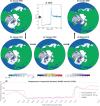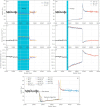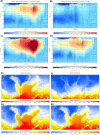Into the Holocene, anatomy of the Younger Dryas cold reversal and preboreal oscillation
- PMID: 38326537
- PMCID: PMC11291662
- DOI: 10.1038/s41598-024-53591-2
Into the Holocene, anatomy of the Younger Dryas cold reversal and preboreal oscillation
Abstract
During the most recent deglaciation, the upwards trend of warmer Northern Hemisphere (NH) temperatures was punctuated by a rapid and intense return to glacial conditions: the Younger Dryas (YD). The end of this event marks the beginning of the Holocene. Using the University of Toronto version of CCSM4, a model of the climate prior to the YD was created with correct boundary conditions. Various amounts of freshwater forcing were then applied to the Beaufort Gyre for forcing intervals ranging from 1 to 125 years. In several cases, this was sufficient to collapse the Atlantic Meridional Overturning Circulation (AMOC) and cause significant cooling over the NH. Crucially, after the forcing was ceased, the AMOC stayed in an off state for approximately a millennium before mounting a rapid recover to pre-YD levels. This recovery, which permanently reduced the extent of NH sea ice, occurred through the mechanism of a Polynya opening in the Irminger Sea during winter and led to a pronounced "overshoot" of the AMOC, during which NH temperatures were higher than before the YD.
© 2024. The Author(s).
Conflict of interest statement
The authors declare no competing interests.
Figures




References
-
- Peteet, D. Global Younger Dryas?. Quatern. Int.28, 93–104. 10.1016/1040-6182(95)00049-o (1995).10.1016/1040-6182(95)00049-o - DOI
-
- Hartz, N. & Milthers, V. Det senglaciale ler i Allerod Teglvaerksgrav. Meddelelser Danmarks Geol. Forening8, 31–59 (1901).
-
- Fairbanks, R. G. A 17,000-year glacio-eustatic sea level record: Influence of glacial melting rates on the Younger Dryas event and deep-ocean circulation. Nature342, 637–642. 10.1038/342637a0 (1989).10.1038/342637a0 - DOI
-
- Peltier, W. R. & Fairbanks, R. G. Global glacial ice volume and Last Glacial Maximum duration from an extended Barbados sea level record. Quatern. Sci. Rev.25, 3322–3337. 10.1016/j.quascirev.2006.04.010 (2006).10.1016/j.quascirev.2006.04.010 - DOI
Grants and funding
LinkOut - more resources
Full Text Sources

